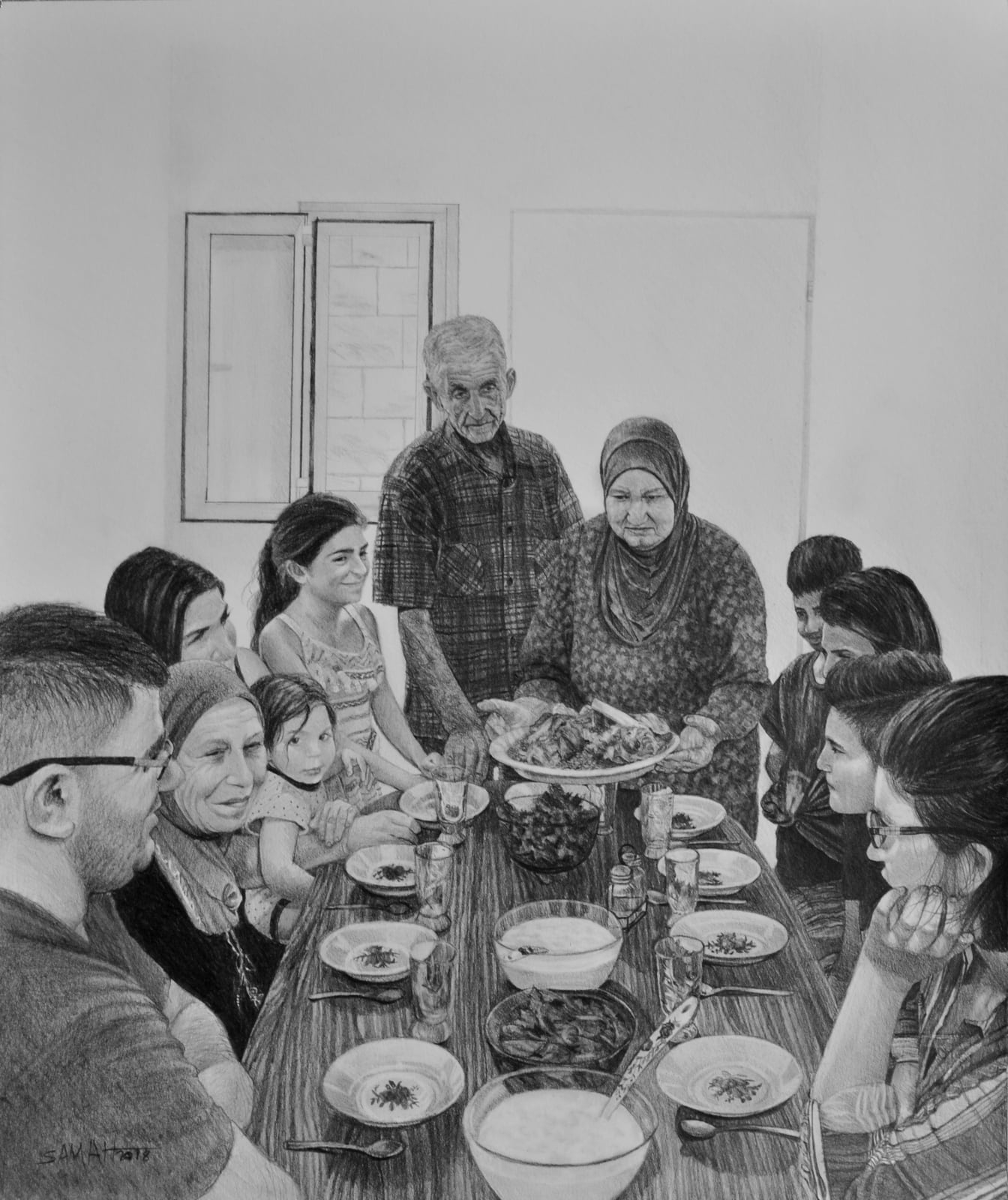Samah Shihadi Palestinian, b. 1987
13 x 15 3/4 in
Exhibitions
Hungry for Home is a collection of 35 compelling hyperrealist pencil and charcoal drawings that use traditional Palestinian food as a platform from which to explore deep-rooted cultural codes and memories. The act of eating is a powerful and intimate practice, the textures and flavours we encounter are absorbed into not only the body but also the memory. Food is something that we unite over and which can draw companionship into our lives. Shihadi’s powerfully realistic drawings, more closely aligned with photographs, use Palestine’s dishes and communal eating practices to communicate the collective experience of lost identity, displacement, and ultimately the artist’s aspiration to return home. “For the Palestinians living in the diaspora the table is an anchor point,” says Ranya Tabari Idliby, Palestinian author, based in New York, whose excerpts of writings on the same subject are displayed alongside the artworks. “It’s where families gather, and community is built. It’s where memories of a Palestine lost are shared and where a threatened Palestinian culture lives and thrives.”
Themes of nostalgia and displacement unite the women, despite their distinct practices set against the context of continuing geopolitical unrest in Palestine, both Shihadi and Tabari Idliby express a desire shared by many in the Palestinian diaspora to return to one’s roots.
Currently based in Haifa, Israel, Shihadi employs hyperrealist techniques to faithfully recapture the world she encounters. Since moving away from her family in Palestine to Israel, the artist finds comfort in food and cooking, a tangible reminder of her childhood and family; for Shihadi the family table becomes emblematic of one’s home, with Palestine’s traditions, recipes and stories being reawakened. This shared nostalgia becomes an anchor for the displaced and exiled, to their family past.
With the works in this exhibition, the artist depicts foods that are locally sourced in Palestine, including olives, thyme, grape leaves, legumes, fruit and milk. The indigenous cactus, a motif often used in Palestinian culture to represent a physical and emotional attachment to the land - as well as an emblem of Palestinian dispossession - is widely represented in Shihadi’s work.
Tabari Idliby’s parents, both born in historic Palestine, were exiled in 1948 following the declaration of independence by Israel. Having grown up in Kuwait, the writer would learn about much of her heritage across the dinner table.
Tabari Idliby‘s excerpts are also included in the exhibition catalogue.
The body of work produced for Terra Un(firma) is divided into two segments, The Living and The Land, which take the artist’s personal narratives and feminist outlook as a starting point from which to explore issues faced by women, across cultures, in the contemporary moment. The Living is a reflection upon the artist’s complex and conflicting internal (psychological) and external (social) worlds.
As a dual marginal existing within a liminal space Shihadi navigates the clashes between individuality and responsibility that comprise contemporary womanhood in her society and extend towards women, globally, who face discrimination, marginalisation, identity crisis and other multi-faceted gendered issues.
The selected works for The Land turn towards the physical space and natural environment as a site of connection, displacement and contestation, which the artist conflates with notions of the home, family and collective identity. Each large-scale work selected for the exhibition has been painstakingly produced over several months. Shihadi’s work oscillates between classical-figurative realism, which dutifully captures and records that which surrounds her and fantastical surrealism that draws from the artist’spreoccupations with mysticism. Shihadi employs a dramatic approach to hyperrealism sketching using chiaroscuro to form a magical reality which blends both fiction and fantasy. Symbolism - religious, ritualistic, political, and cultural - is interwoven into much of Shihadi’s work, forming complex layers that the viewer must unpack in order to absorb deeper meanings.

